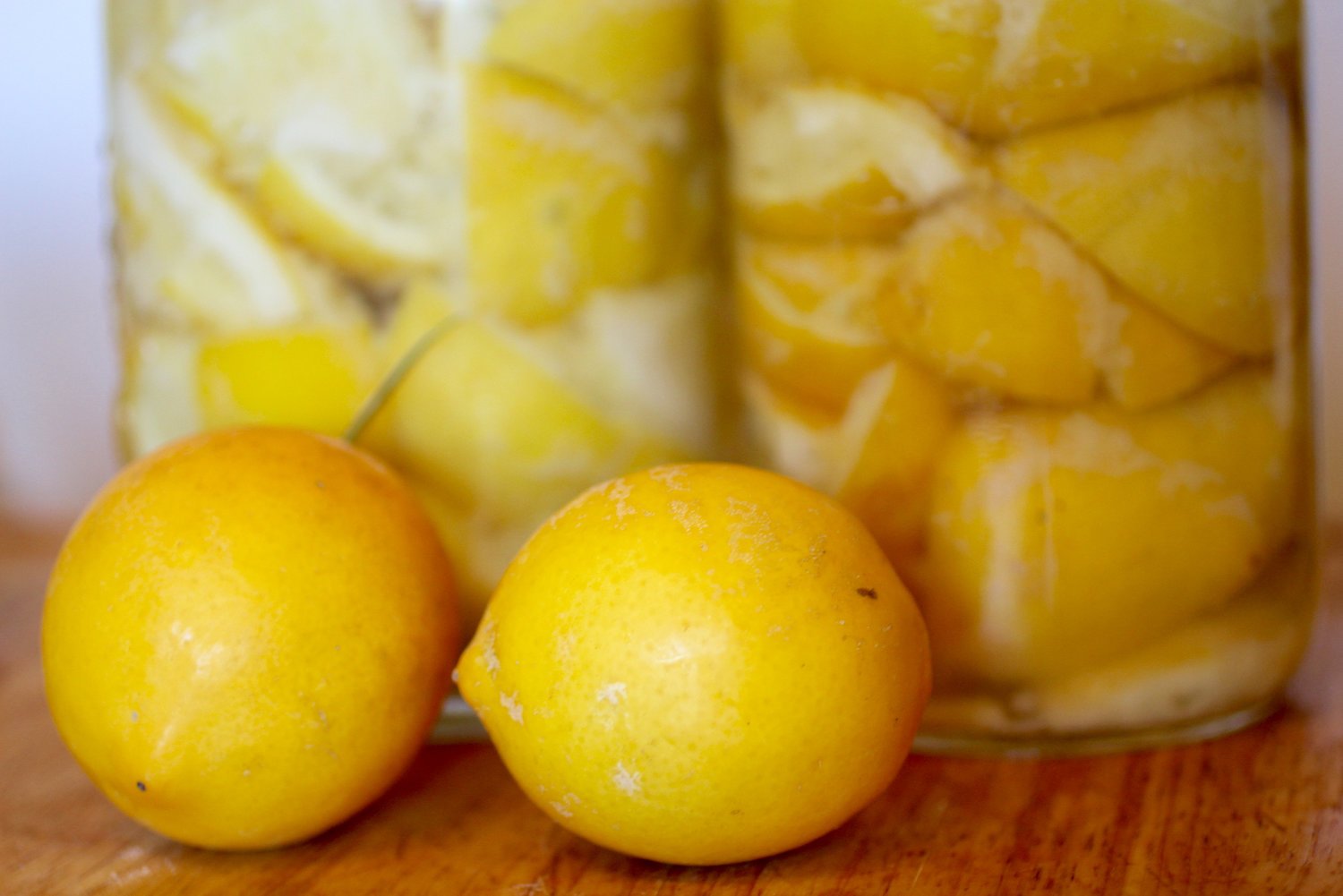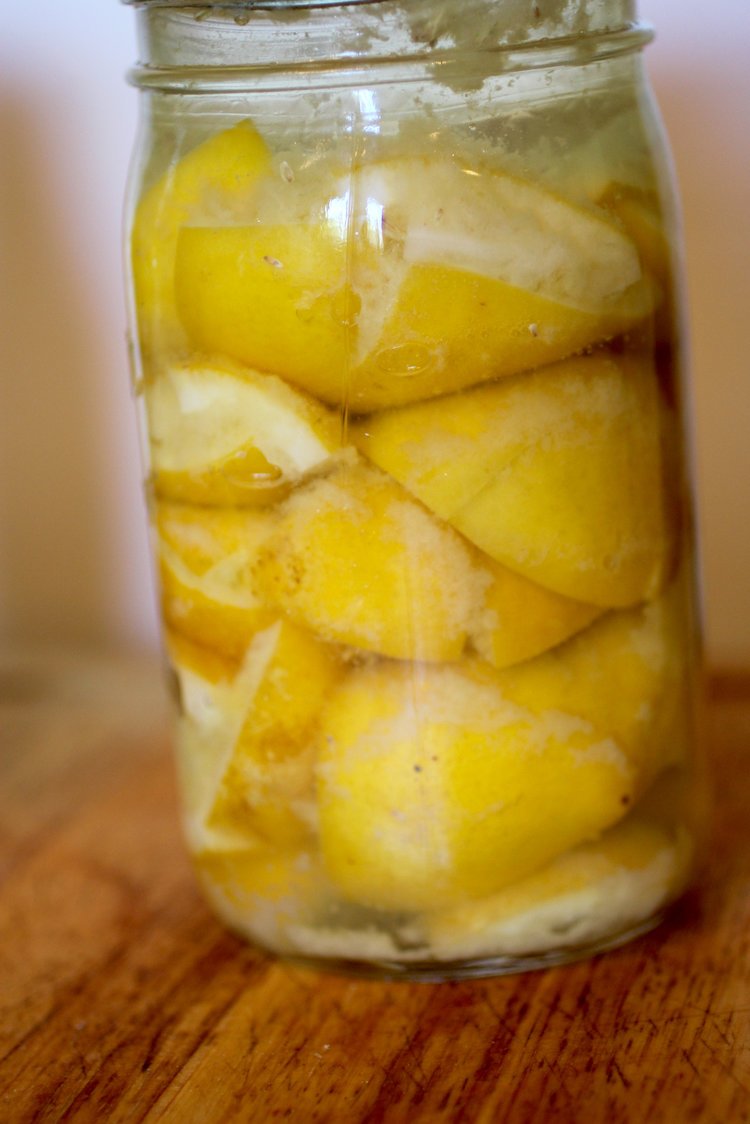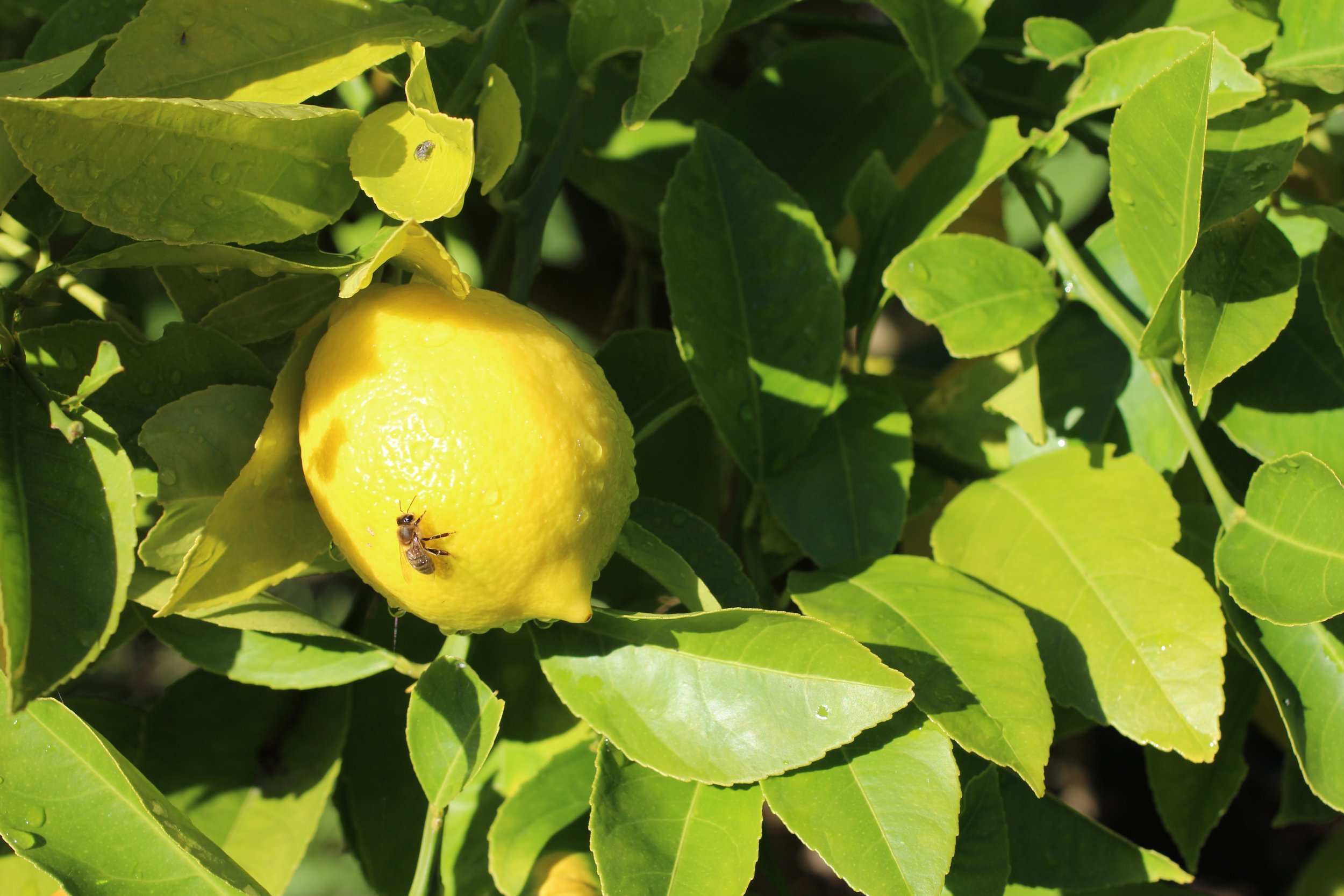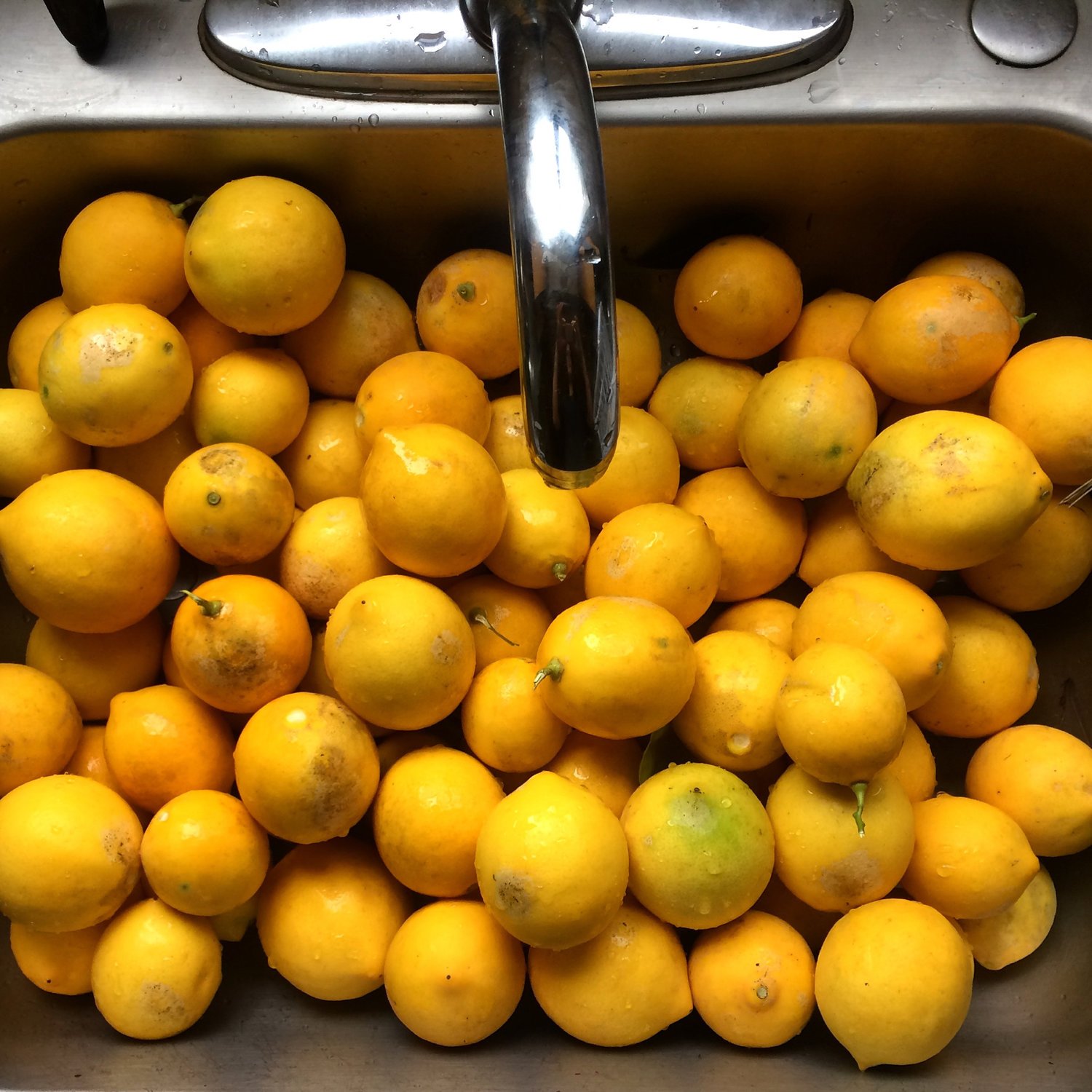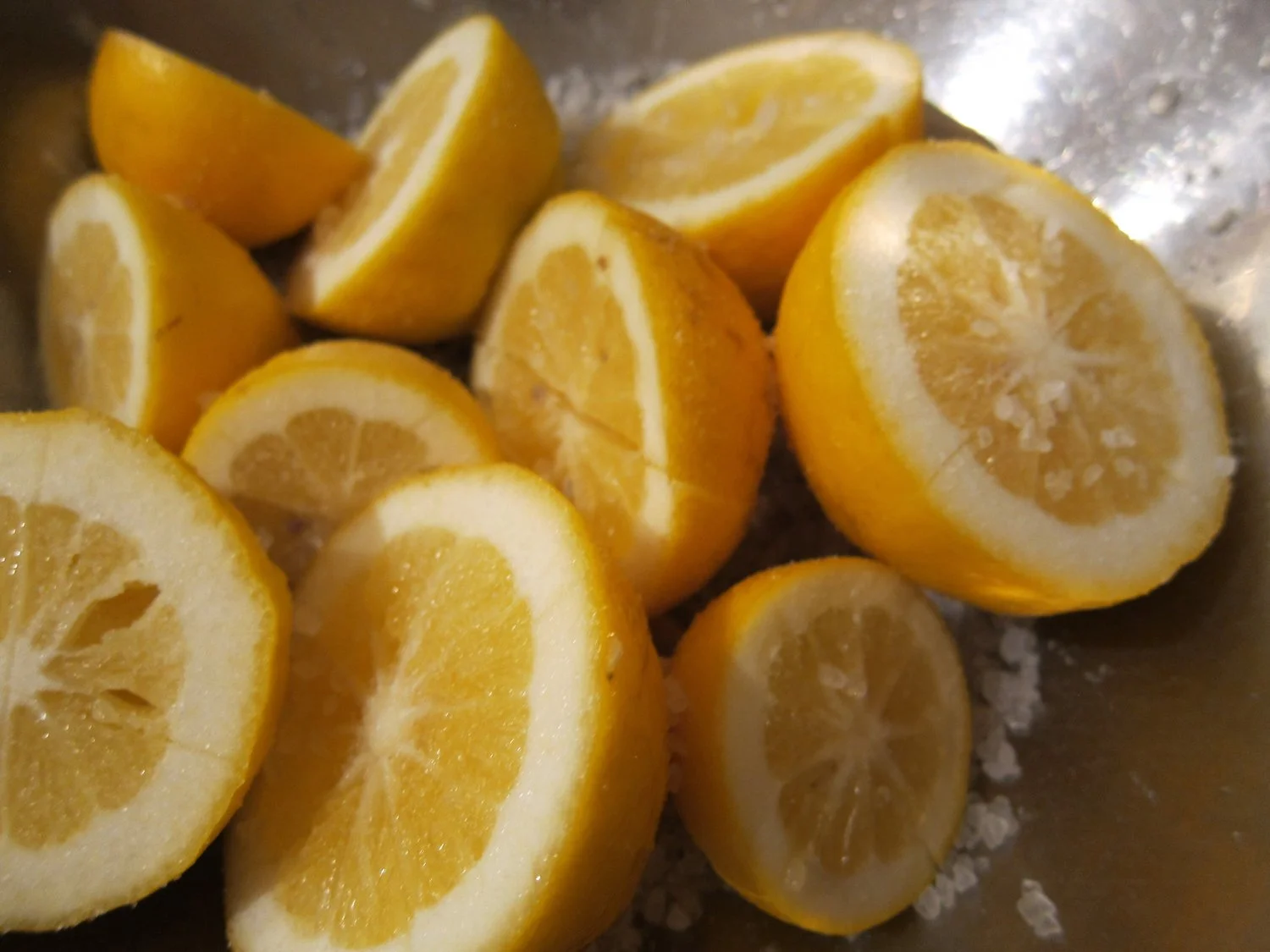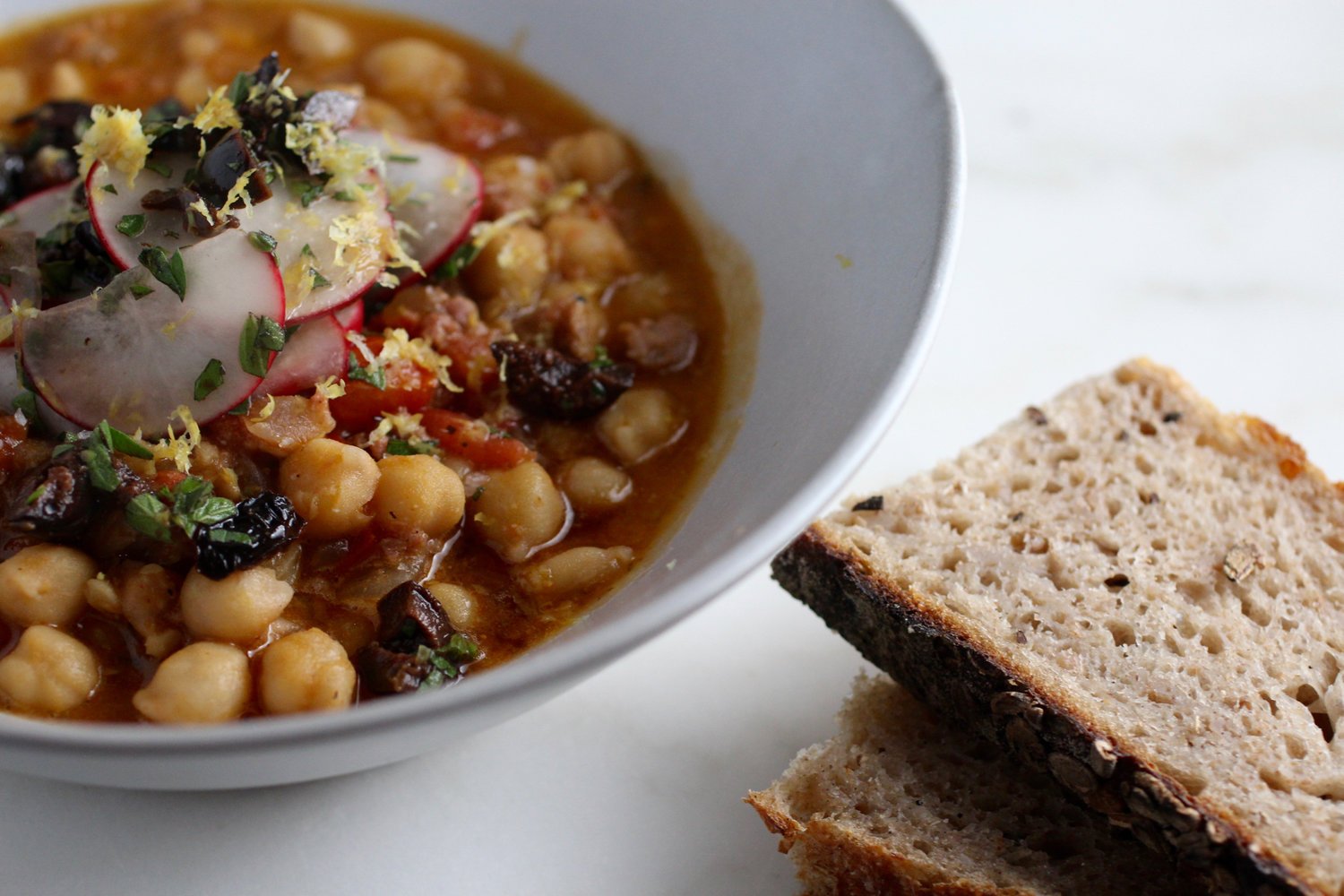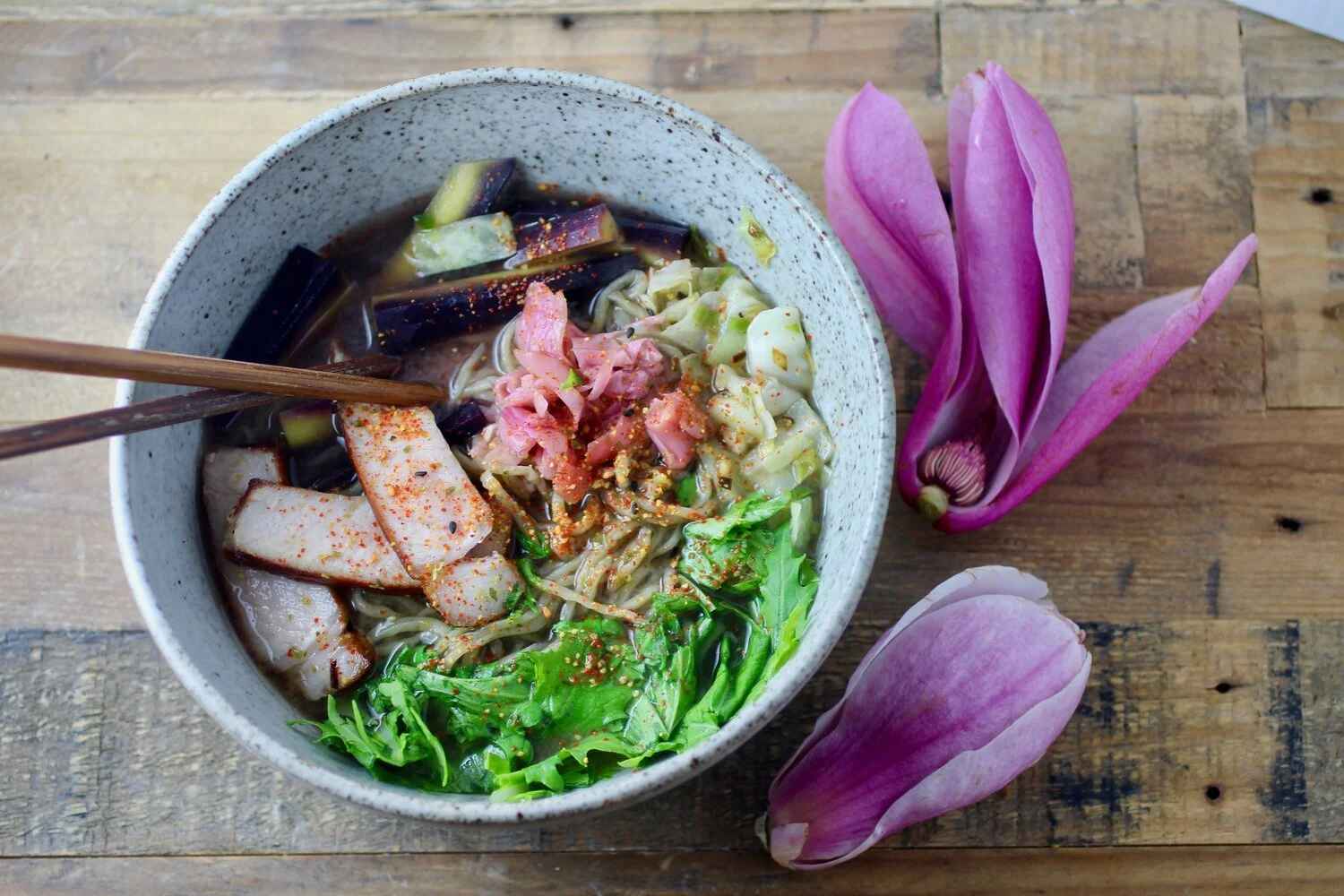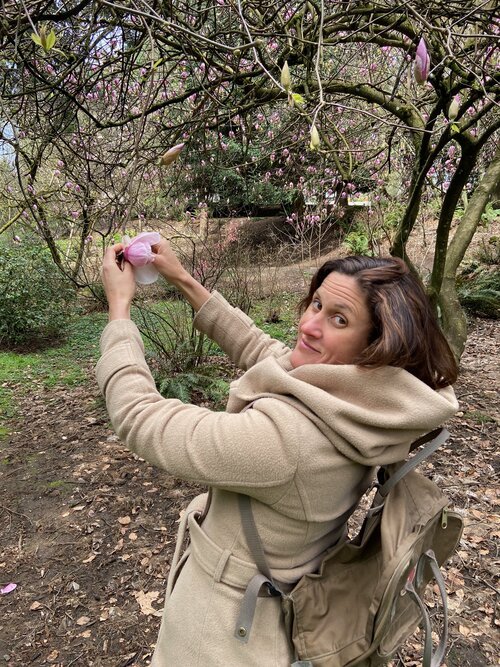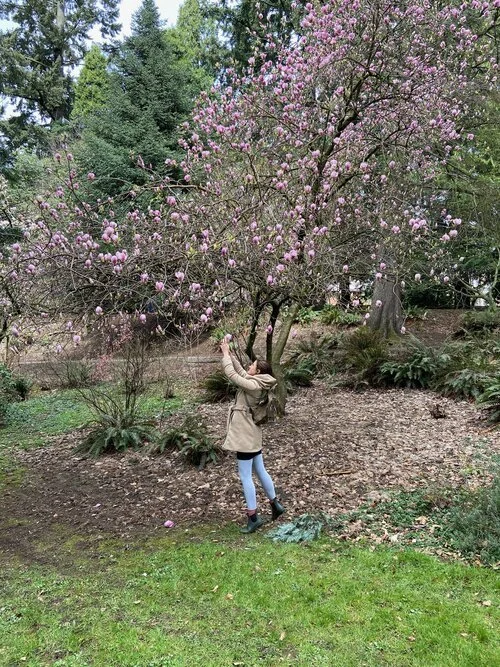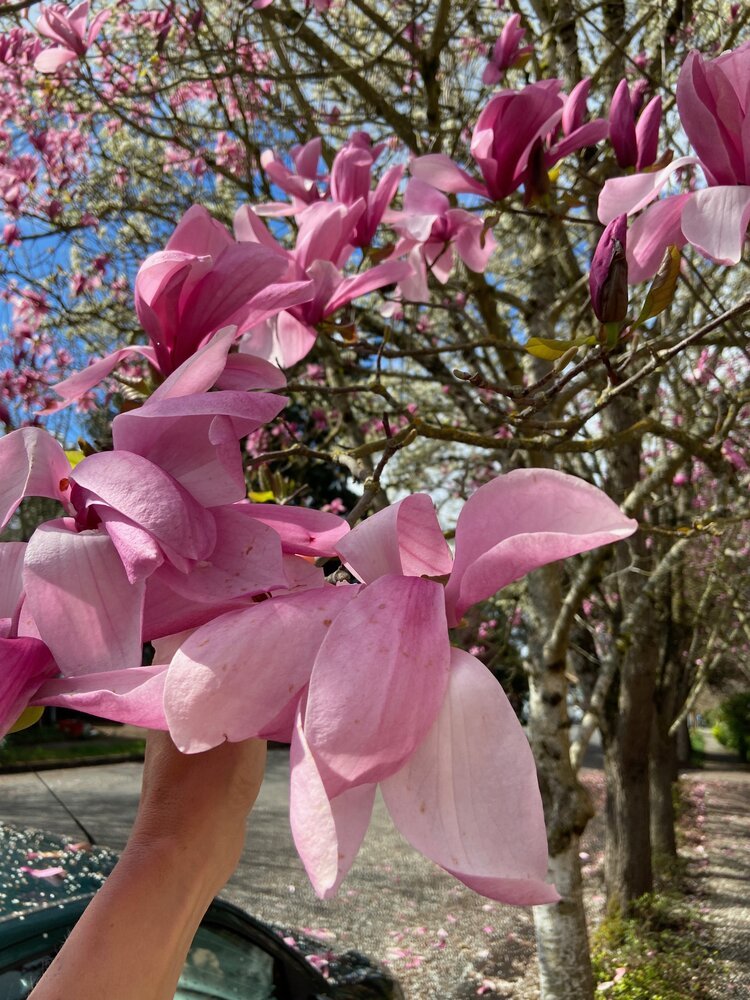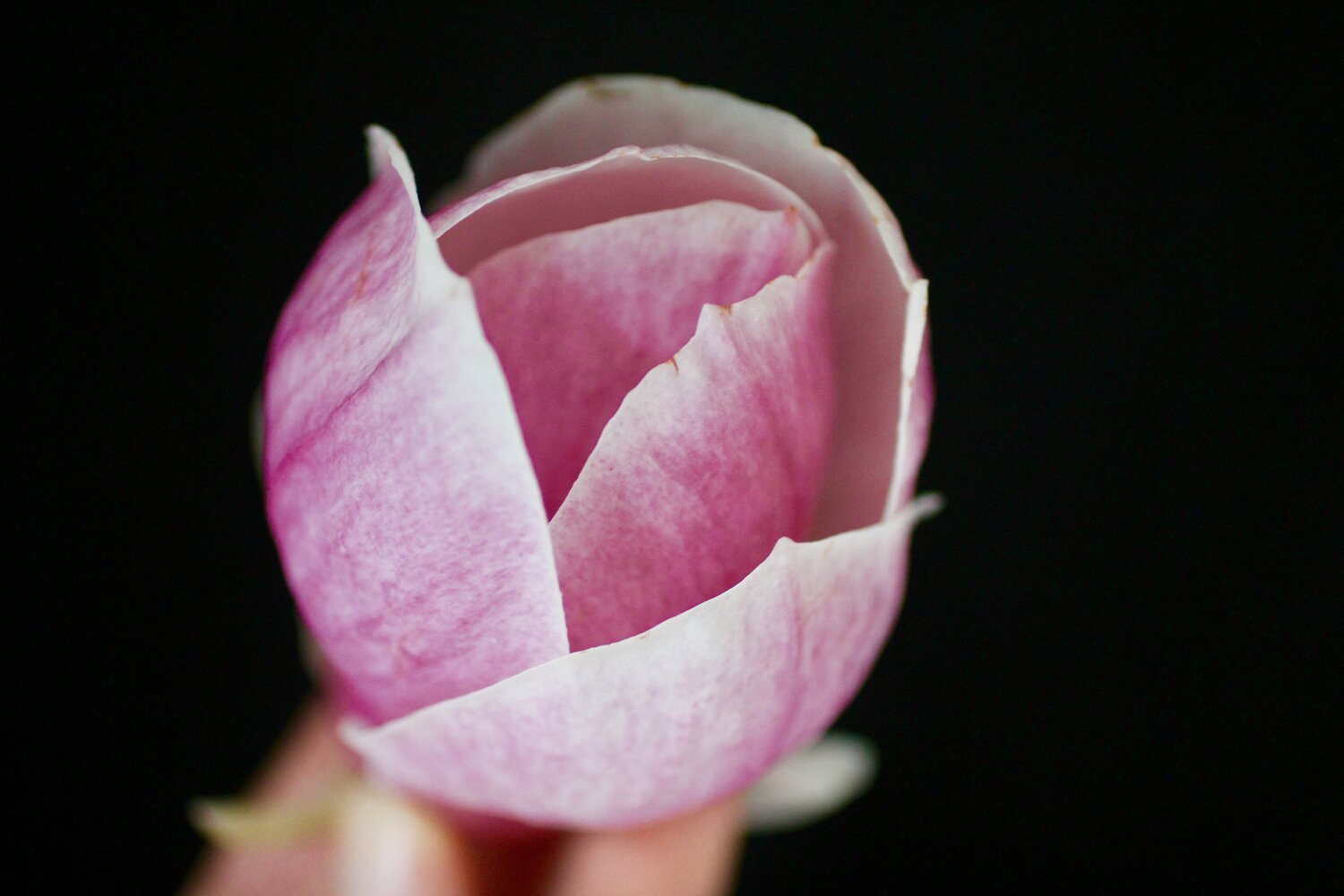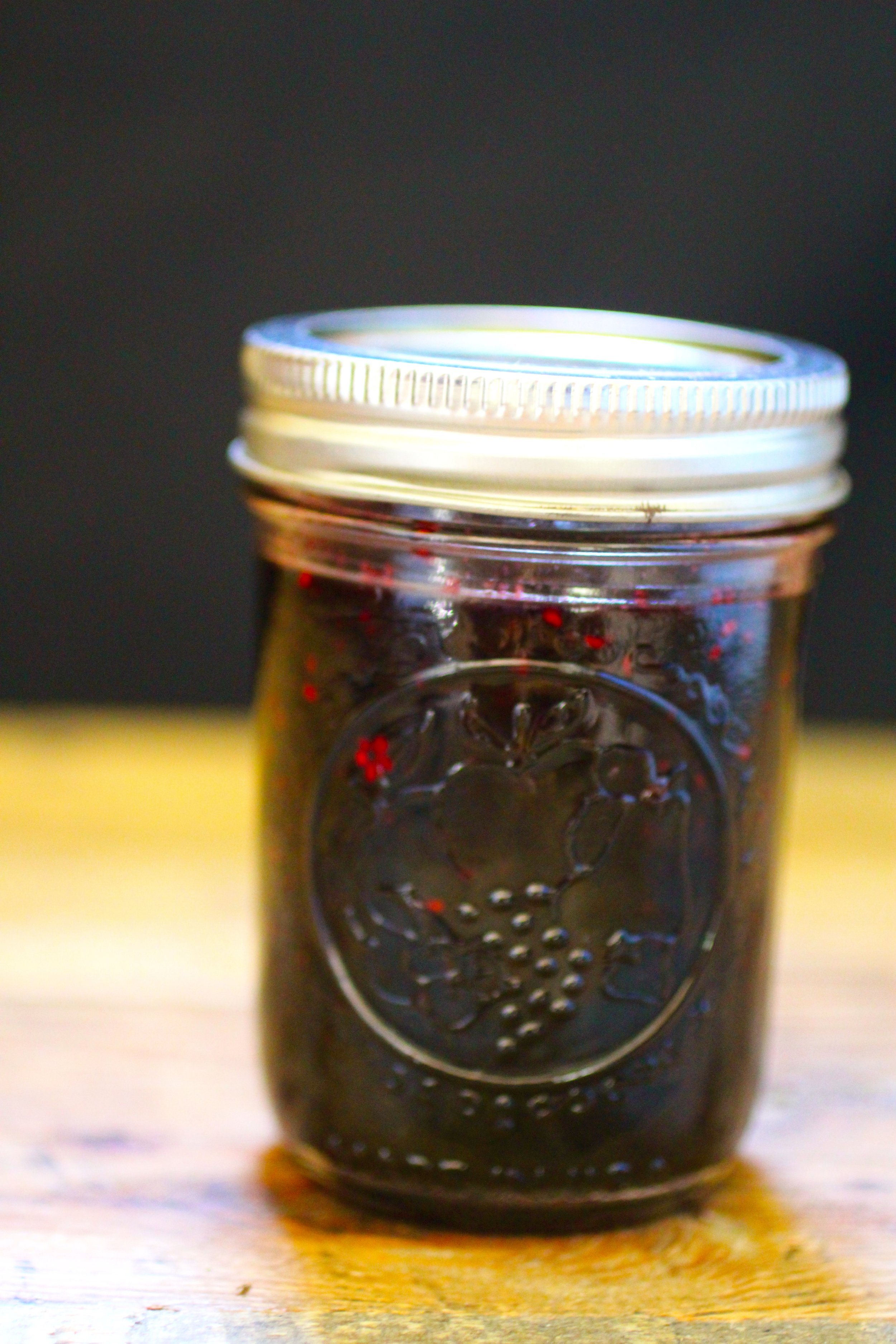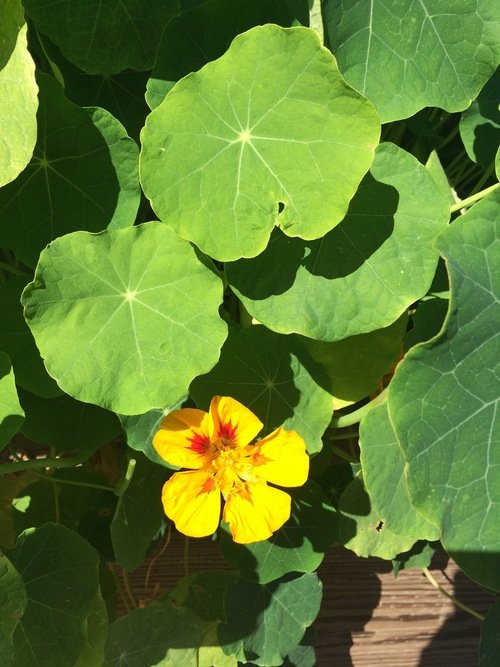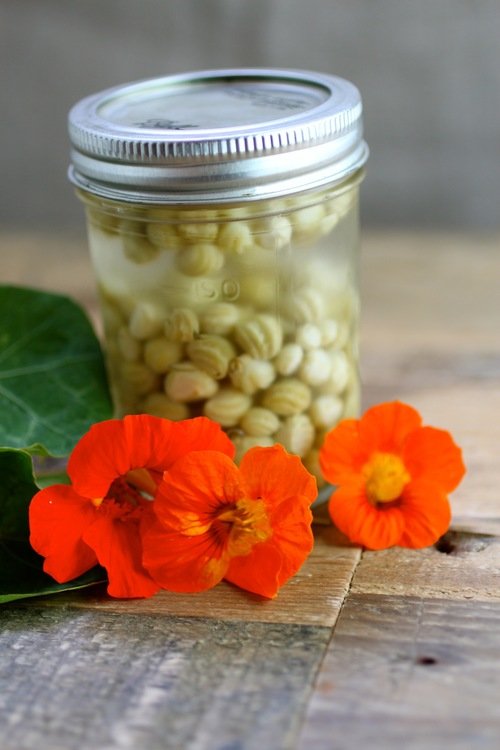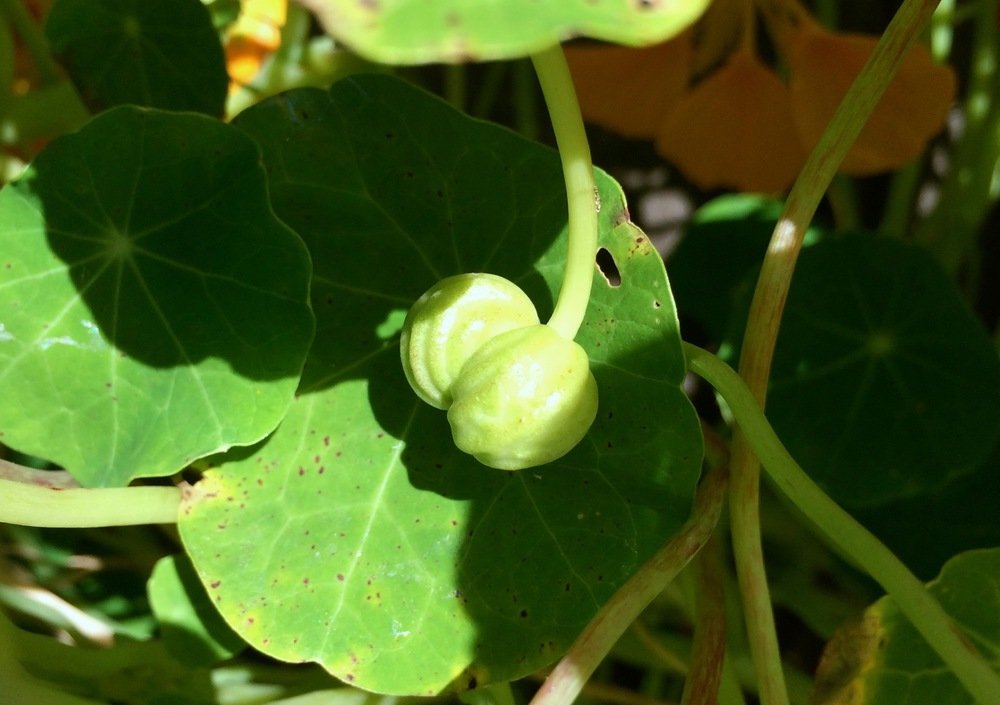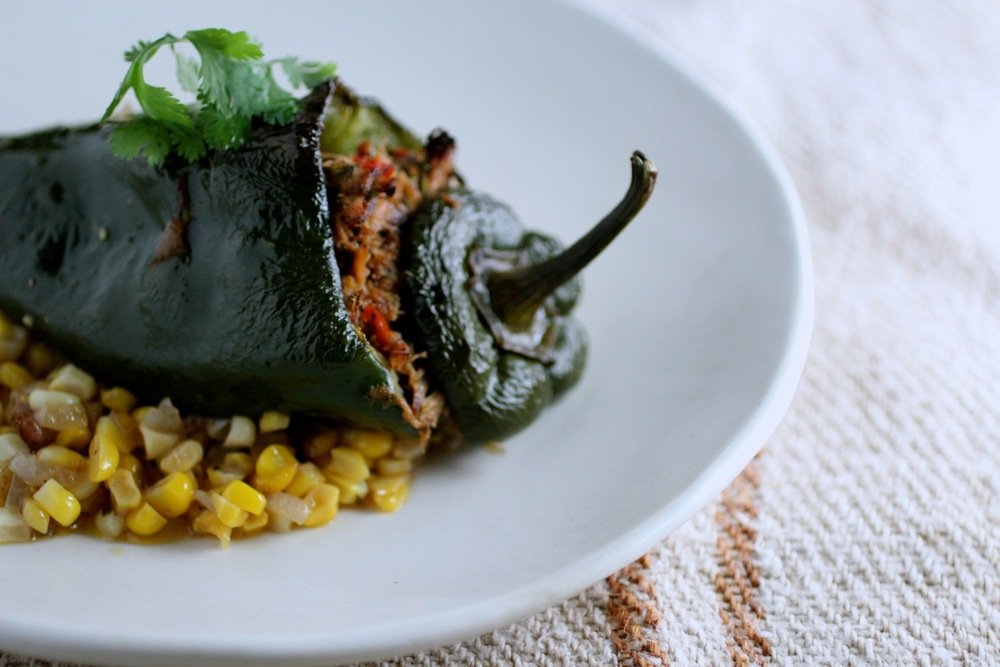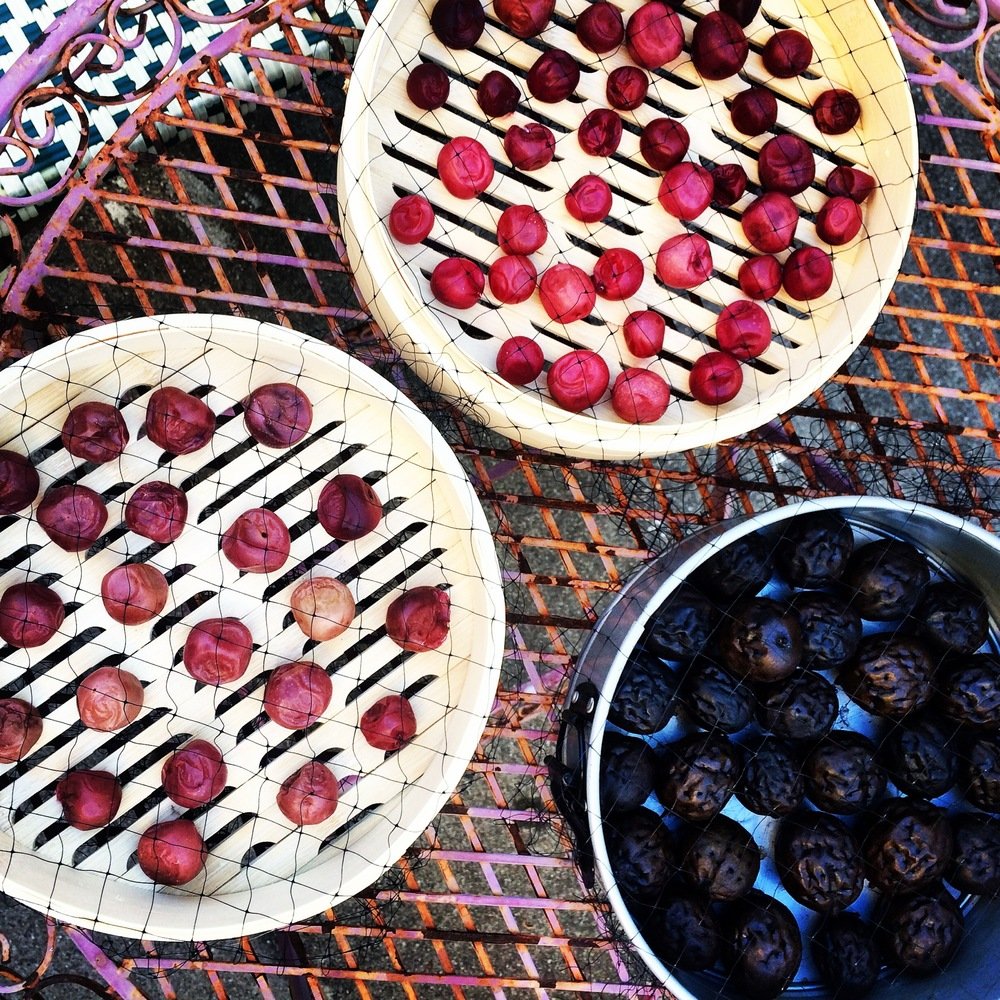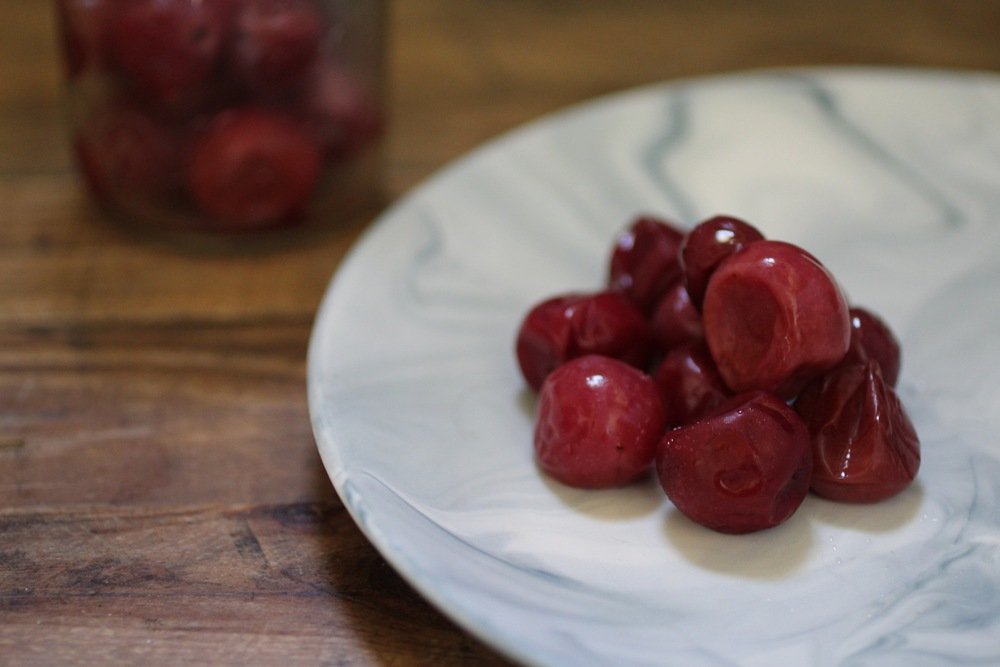Preserved Lemons
You know what they say - when life hands you lemons...preserve them! I don't remember the first time I made preserved lemons and discovered how incredibly easy it is, but I do know that I've been making them pretty much at least once a year ever since. By rubbing generously with salt and pressing under the saline brine created, fresh whole lemons are transformed over time into the best kind of funky, fermented condiment. The very acidic, salty, and oxygen-free (because you submerge them under water) environment keeps the bad microbes out while the good microbes take over to create a more delicate texture and heighten deliciousness.
Complex flavor from a simple, salty ferment.
Preserved lemons are common to Moroccan/Mediterranean/Middle Eastern cuisine, but the possibilities don't stop there. I like to chop them up and use them on all kinds of foods such as sautéed greens, grain pilafs (think couscous with cinnamon and toasted almonds/pine nuts), roasted winter squash, chickpeas or other beans, grilled fish, and slow-cooked meats or soups (think chicken with olives and saffron). Really, the possibilities are endless and delicious - adding preserved lemon is the easiest of ways to impress your friends when you serve them a meal ("what's that delightfully savory-sour flavor, you ask? Why, my own preserved Moroccan lemons of course!") I was fortunate enough recently to come across a laundry basket's worth (literally) of lemons from my parents and couldn't think of a better way to harness the power of a garden lemon for a later date.
Hello bee!
When life hands you lemons…(from your parents’ tree)
A bunch of lemons (example: 10 lemons)
A bunch of coarse sea salt (example: 1/2 cup salt)
Additional lemon juice and salt as needed
Other ingredients if desired such as bay leaf, peppercorn, coriander, clove (I never use additional ingredients, as I like the lemon flavor to shine on its own)
Wash mason jars (a one-pint jar will hold 3-4 lemons) with hot soapy water and wash lemons well with water, scrubbing off any dirt. For 10 lemons, you will about 4 one-pint jars or about 2 quart jars.
Cut lemons in half then quarter each half without cutting all of the way through so there are 4 attached segments on each half.
Rub lemon halves all over with salt, making sure to get in between the crevices, and press down into jars as you go. Press lemon halves on top of each other into jars tightly, squeezing out as much water as possible.
The lemons in each jar should be submerged in their own salty lemon juice. If they aren't submerged, add more lemon juice and press down again. You may need to wait a few hours and press down another time (making sure to wash your hands any time you come into contact with the lemons), as they absorb liquid and are easier to press down over time. I like to also put something (that has been well-cleaned) on top of the lemons so that they stay submerged. A smaller jar (such as a 4-ounce jar) filled with water works well for this. I have also used plastic bags filled with water for this purpose.
Leave on the counter for about 3 weeks then screw on lid and store in the refrigerator for up to one year (even 2 years in some circles, but they probably won't last that long!)* To use, remove rind, rinse, chop, and add at the end of cooking. Juice (and even chopped pulp) can be used as well - it's not as common, but has a similar flavor!
Lemons halved and quartered so segments remain attached before salting.
Chickpea soup with preserved lemon juice, tomato, olives, and lemon zest.
Pickled Magnolia Blossoms
Pickled magnolia blossoms
Fresh and pickled magnolia blossoms.
When magnolia trees bloom, they aren’t shy about it - they burst forth in seductive, fragrant glory and leave a slew of thick, oxidizing, hard-to-clean-up flowers in their wake. I love them for this and was pleasantly surprised to find out that the blossoms are also edible. Let’s be honest, these past two (pandemic) springs has been surreal and anxiety-provoking, so having an excuse to go outside and work on a foraging project is and was definitely appreciated. Most magnolias bloom in the spring and all varieties of Magnolias are edible - star magnolia, saucer magnolia, lily magnolia - you name it. The blossoms have variations in color/flavor/texture, so I’d recommend tasting a sliver and seeing what works best for you. Fresh, they have a texture similar to endive with a spicy/floral flavor.
Uses: Prior to this experiment, I’d only used fresh magnolia petals to top desserts, more for decorative purposes than anything. But, you can also use them in small amounts in salads/grain bowls/etc. or they can be pickled, which is the most common application. I would like to try infusing a liquor with them as well, but haven’t gotten around to that yet! Any time you handle the flowers (if you care at all about their appearance) it’s important to be very careful, as the petals bruise/brown easily.
Gorgeous magnolia blossom - for eating raw, the younger leaves are best.
Pickled Magnolia Blossoms: This recipe is an adaptation/combination of two recipes I found (shoutout Medium and eatweeds.co.uk) along with what seemed like it would work and taste the best to me. You can liken the final product to a strong/very floral pickled ginger (with an appearance/texture to match). As you might guess, they work really great with Japanese/Asian flavors like sesame, soy, and seaweed - I’ve used them in a miso noodle bowl (pictured below) and am looking forward to trying it out in a brown rice/sesame bowl or maybe with some homemade sushi/salmon? I could see pickled magnolia being great in any application where pickled ginger sounds good, but also creamy foods to counter the spicy like a compound butter or mild fresh cheeses. The vinegar can be used as you would use regular vinegar as well - for both petals and vinegar, a little goes a long way. Below recipe makes about 1 cup.
220g magnolia flowers (about 6-7 cups packed) - For pickling, it’s ok to have older leaves. For eating fresh you want the younger nicer leaves.
500mL rice vinegar (about 2-¼ cups) - Other light-bodied vinegars or a combination also works, I see a lot of people use apple cider vinegar, but I wanted the subtlety of the rice vinegar.
110g granulated sugar (about ½ cup)
2 teaspoons Kosher salt
To Prepare
Clean and dry flowers - carefully so you don’t bruise the petals.
Add petals to a quart jar or two pint jars (pack tightly). Naturally, jars should be clean.
Heat vinegar with sugar and salt to simmer and sugar/salt is dissolved, stirring as needing.
Pour hot brine over petals.
Using a clean spoon or other utensil, submerge petals under brine several times as they inevitably rise to the top. Optional: I like to use a clean plastic bag or smaller mason jar with a little water to make sure the petals stay submerged.
Cover with lid, allow to come to room temperature, then refrigerate.
Pickled blossoms are ready in 24 hours and will keep in the refrigerator for 4 months to 1 year (still looking into this as I keep them in my fridge - I know that the color will become browner).
Pickled magnolia blossoms in a bowl of miso-ramen.
elderberry jam
More information on foraging and exploring elderberry here.
This recipe is a great way to quickly preserve the flavor of elderberries for later use on toast or in dessert applications. Makes 4 half-pint jars.
4 cups fresh elderberries
3 cups granulated sugar
2 tablespoons lemon juice
Sterilize 4 half-pint Mason jars.
Bring ingredients to a boil, stirring until sugar dissolves. Continue boiling, stirring occasionally, until mixture reaches 220° or jam falls in a “sheet” when spoon is removed, about 20 minutes.
Pour evenly into jars and seal.
California Capers
California Capers.
As I explore in a previous post, the nasturtium plant (Tropaeolum majus) has so much more going on than a pervasive vine with peppery bright flowers, including incredibly spicy leaves and (the subject of this post) pungent, clear-your-nasal-cavity seed pods. You want to pick the seed pods when they're young and green, as they toughen and get bitter with age (but are still edible). Try them raw - their wasabi-like flavor is so intense, it'll wake you right up! I like eating them as a snack, but as they are so intense a little goes a long way. By pickling them, you can preserve and enjoy these pearls of flavor for up to one year. As with most things in the culinary world, someone else has already done this and coined them "California Capers" - a designation I love and truly wish I'd created!
The nasturtium plant in all its glory.
Nasturtium seed pods stuck together in groups of three - these need to be separated before washing and preserving.
Don’t worry about sounding professional. Sound like you. There are over 1.5 billion websites out there, but your story is what’s going to separate this one from the rest. If you read the words back and don’t hear your own voice in your head, that’s a good sign you still have more work to do.
Be clear, be confident and don’t overthink it. The beauty of your story is that it’s going to continue to evolve and your site can evolve with it. Your goal should be to make it feel right for right now. Later will take care of itself. It always does.
I've tried making California capers a few ways, some ways more complex than others, but I find that I like the simple version from this site best, with a few alterations. If you find the caper pungency to be too strong, you can always submerge them in a salty brine for a few days (1/4 cup salt: 2 cups water). Pickled nasturtium pods work anywhere you'd use regular capers - they're amazing on bagels and lox (anything with smoked or preserved fish, really), pasta pomodoro, braised chicken, in tuna or egg salad, green salad, etc.
Makes 1 pint
1-1/3 cups young nasturtium seed pods
2 bay leaves
About 1-1/3 cups distilled white vinegar
2 teaspoons Kosher or sea salt
Separate seed pods that are stuck together - they are often joined in groups of three.
Soak seed pods in water to remove any dirt/debris, then drain and place in two sterilized half-pint jars along with 1 bay leaf per jar.
In a small saucepan over medium-high heat, bring the vinegar and salt to a simmer and stir until salt is dissolved. Pour hot vinegar mixture over seed pods, covering them completely.
Let the jars cool to room temperature before sealing with lids. Refrigerate for at least 24 hours before eating and enjoy for up to one year.
Umeboshi with Wild Plums
Umeboshi wish California wild plums.
Wild plums and red shiso make for impressive color.
As it turns out, you can't find ume plums (Prunus mume) easily on the West Coast to make a truly traditional umeboshi, or Japanese salt-pickled plum. Fortunately, wild plums are small and tart enough to work in much the same way. Ume plums are actually more closely related to an apricot, so if you eat them raw the texture will (theoretically, I have never eaten them myself) be very different than a wild plum from the West Coast, but when pickled the different is very subtle.
By preserving wild plums in salt, you keep the harmful bacteria out and, over time, create many amazing complicated flavors. The resulting wild plum umeboshi can be chopped and used as a condiment to bring bright, tart, pungent, savory/sweet flavor to a wide variety of dishes. Traditionally, it's eaten with rice, but I've tried it sautéed with sweet corn and in a nectarine compote that topped seared pork and I'm definitely looking forward to more experimentation! The salty-tart juice leftover from the umeboshi can be used for quick-pickling radishes or as an interesting addition to sauces and dressings.
One of my favorite discoveries - sautéed sweet corn with umeboshi and butter.
The below recipe is adapted from from here, which is supposedly the most popular umeboshi recipe translated into English and can be adjusted as needed for amount of plums that you have. We made a few batches with shiso (purple shiso from our garden) and a few without and although the shiso is nice, it's pretty subtle and both versions are great. Be careful handle the plums VERY gently - any bruising and cutting can lead to mold.
1 pound (metric example = 1 kilogram) small wild plums, about the size of cherries or slightly larger and still firm (we picked up red ones from Tilden Park - yellow can be used, but the color will not be as characteristic)
2 cups (metric example = 1 liter) vodka or other distilled alcohol (such as shochu), for rinsing plums
1.6 ounces (metric example = 100 grams) red shiso leaves (about 10% by weight of plums)
1.6 ounces (metric example = 100 grams) coarse sea salt or Kosher salt (10% salt solution)*
Step 1: Sterilized the plums and process the shiso
Remove stems from plums. Wash plums in water twice then soak in a bowl of cold water and allow to soak overnight. This removes some of the bitterness in the plums (wild plums are less bitter than ume plums, but I went ahead and did this to be safe).
Drain plums, dunk in a bowl of vodka, and set out on a clean towel to dry. The alcohol helps to ensure any mold spores that might still be on the outside of the plum are removed/rendered safe.
Wash shiso leaves, remove tough stems, sprinkle with salt and massage leaves with fingers until they are limp.
Step 2: Get your plums nice and salty so they ferment
Clean a large, wide-mouthed container (such as a gallon-sized jar) that can hold all of your plums. Spray with vodka to disinfect it, then allow to air dry.
Fill your pickling container with salt and plums by starting with a layer of salt, then a layer of plums, followed by a portion of shiso. Repeat until all ingredients are used and weigh down with a plastic bag filled with water or another smaller jar filled with rocks and water (make sure these are clean). Once the container is full and weighed down, cover the top with cheesecloth and secure with a rubber band. You might have to wrap cheesecloth around the weight then secure with a rubber band. As long as the top is covered with cheesecloth, all is well. It doesn't have to be pretty!
Salt, shiso, and plums weighted down and covered with cheesecloth.
Leave fermenting plums in a cool, dark area until the plums are soft and completely immersed in a reddish liquid (about 1-2 weeks). This liquid is extracted from the plums by the salt. If liquid is not completely covering plums, try increasing the weight. Liquid should be about 1 inch above the top of the plums. Leave the plums in the liquid until you are ready to dry them, about 2-3 weeks.
Step 3: Hoshi/boshi ("to dry") your plums
Wild plums (or ume plums in Japan) are harvested in June and drying traditionally occurs on a specific date after the rainy season is over. Be sure to dry your plums at a time when the weather is dry and at least 2 weeks after plums have been submerged in liquid.
Put the plums in a single layer and the shiso leaves in spread-out clumps separately on flat baskets - we used a bamboo steamer - . Leave the baskets outside in a sunny place with good ventilation for about 3 days, turning them at least every 24 hours. If it rains, be sure to take them inside before they get wet. At the end of the drying process, they should look wrinkly.
Umeboshi drying on bamboo steamer liners. Also in the photo are green walnuts in the process of pickling (but have nothing to do with the umeboshi, don't be confused!)
Step 4: Store and enjoy
Store plums in jars, pouring back in some of the ume liquid if you prefer softer plums (we did not do this, as we like them firmer). As I mentioned earlier, this ume liquid can be used for other things, such as quick pickles. The shiso leaves can be layered in with the plums, but we keep the shiso out for other uses, as they didn't have the best texture and we wanted to keep our umeboshi "clean". The umeboshi is now ready to eat - they can be eaten for up to 10 years (!) and grow in complexity over time, but I doubt we'll still have ours after even 1 year!
*Other salt solutions can be used, from 8% - 20%. The higher the salt percentage, the saltier the umeboshi will be (obviously). The lower the salt percentage, the more likely they are to mold. It is recommended that beginners use at least 10%.
Finished umeboshi straight from the jar.
Plum-Rosemary Jam and Spiced Chutney
One neighbor's discarded plums are another's treasure.

Preserves are a great way to preserve!
There are times that I especially appreciate how fortunate I am to live in California. Plum season is one of those times. During the months of June, July, and sometimes August, many neighborhoods in the Bay Area are literally dripping with plums. These plums are often there for anyone willing to put in the effort, as many plum tree owners can't seem to keep up with the production. While the small and tart wild plums that you can find in many parks and urban environments are lovely (especially for California wild plum umeboshi, recipe coming soon!), the Santa Rosa plums that are much-loved cultivated variety in the area are pretty ethereal. They are sweeter, but not cloyingly so, with beautiful flesh and an almost rose-like scent. When my neighbors told me that they had more of these plums than they could handle and told me to take as many as I could I knew I hit the plum jackpot. Low hanging fruit for sure!

I gotta lotta neighbors with a lotta unused plums.
There are many ways to enjoy plums like use them in place of apricots in this ginger almond galette or simply eat them fresh and let the juices run down your chin, but if you're in need of putting up (isn't that a great phrase?) a lot of them for later use, preserves (hence the name) are a classic way to go. When I have a bunch of fruit, I like to make both jams and chutneys because it's nice to have a classic jam for topping toasts and yogurt, filling pastries, and making cocktails, but chutney is great to have around for savory applications. Serve it with blistered green beans or roast chicken eh, voilà! All of a sudden that ho-hum dish is exciting. The jam uses store-bought pectin - I used to only make my own pectin from citrus pith, but (although fun) it can be quite time consuming and the Pomona pectin is a faster way to success. The quantities and spices in both the jam and the chutney are adaptable to availability and preferences!
Plum-Rosemary Jam
Makes about twelve, 8-ounce jars. Recipe adapted from Serious Eats.

Glorious Santa Rosa plums.
6 pounds plums, pitted and chopped
2.25 pounds granulated sugar
1.5 Tbs Pomona's Universal pectin or other low-sugar pectin
2 Tbs calcium water (comes in pectin package)
2.25 ounces lemon juice (about 2 lemons)
3 sprigs rosemary
Toss plums with sugar and pectin in large bowl. Cover, refrigerate overnight (optional - this may be helpful if you don't have time to make jam after picking fruit and want to save it until the next day).
Put two spoons in the freezer.
Heat in large pot on medium with calcium water, lemon juice, and rosemary sprigs, stirring frequently. Cook for 30 min - 1 hour, skimming off foam* and smashing to desired texture. An immersion blender can also be used to break down fruit, but rosemary sprigs should be removed before blending.
Check for doneness by putting jam on spoon and putting back in freezer for 2 minutes. When you run your finger through the jam on the spoon, it should leave a track and jam should cling to the spoon (rather than running off). The jam in the pot will also be a lot glossier/smooth.
While jam is cooking, wash and sterilize jars and rings by submerging under water and boiling for 10 minutes. Throw in the lids once they’ve boiled for 10min and turn off water.
Remove rosemary sprigs and fill jars, leaving 1/2 -inch headspace. Screw on rings loosely, submerge again in water for another 10 minutes to seal.
Store at room temperature. Jam is good for up to 1 year.
*The foam is tasty and has a cool texture, kind of like meringue! Next time I do this, I want to blend into egg white foam and see if it will set up into a cookie, but is great and fun on desserts regardless.

The flesh is yellow in color and the taste tart-sweet. Cut around the pit, as it does not fall out willingly.
Spiced Plum Chutney
Makes about four, 8-ounce jars. Recipe adapted from Jamie Oliver (with a lot more kick added!)
2.2 pounds plums, pitted and chopped
4 shallots, thinly sliced
1 tablespoon neutral oil (grapeseed or vegetable)
3 fresh bay leaves
7 cloves
9 allspice seeds
1 tablespoon black or yellow mustard seeds
1 tablespoon coriander seeds
2 teaspoons red pepper flakes (optional - this amount is pretty spicy)
1-3/4 cups brown sugar
3 tablespoons grated ginger
Zest from 1 large orange
Juice from 1 large orange
300ml cider vinegar or 200ml red wine + 100ml water
1/2-1 teaspoon salt

Cook shallots in oil on low until golden.
Add bay leaves and all spices except for ginger and sauté for 1 minute.
Stir in plums. Add sugar, ginger, and orange zest. Squeeze juice from orange into measuring cup, top off with cider vinegar or vinegar/water combination until it reaches 450ml. Add this to plums and bring to a boil. Simmer until thick about 30 minutes - 1 hour. Salt to taste.
While chutney is cooking, wash and sterilize jars and rings by submerging under water and boiling for 10 minutes. Throw in the lids once they’ve boiled for 10min and turn off water.
Remove bay leaves and as many allspice seeds as you can and fill jars, leaving 1/2 -inch headspace. Screw on rings loosely, submerge again in water for another 10 minutes to seal.
Store at room temperature. Chutney is good for up to 1 year.

To label jam, I use old paper grocery bags - just trace the outside of a ring, cut out a circle slightly smaller than the outer edge, and then screw on top of the lid.

Phases of plum.


